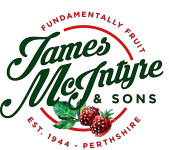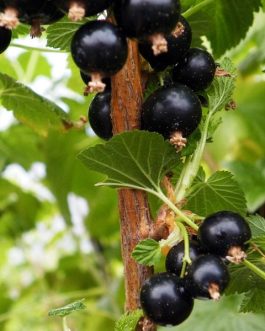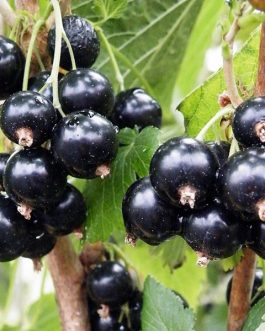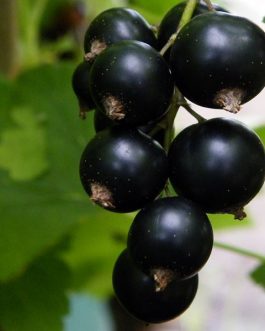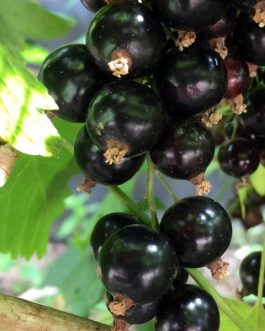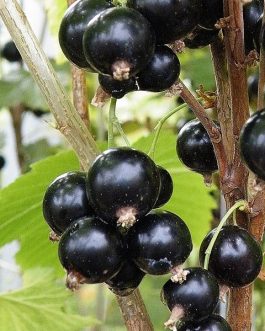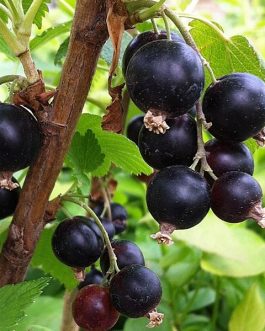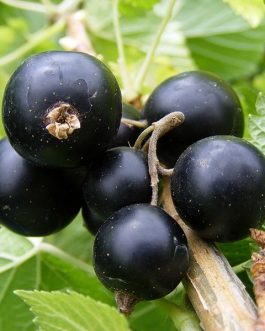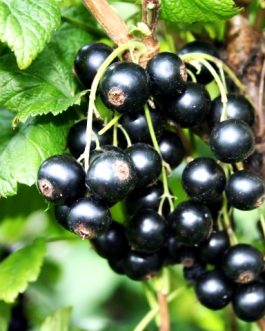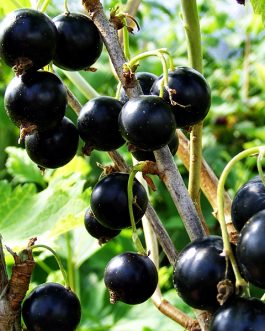Blackcurrant Bushes for Sale
At James McIntyre & Sons we supply an excellent variety of good quality Blackcurrant Bushes in both 3 litres and as bare root plants (depending on the time of year). All of our soft fruits are grown on our East Perthshire farm in the small town of Blairgowrie.
Our Blackcurrant Bushes are varied in type, from our mid-season Ben Alder to our popular early-fruiting Ben Connan variety. Our Blackcurrant varieties have a natural frost resistance and disease resistance against mildew, leaf spot and leaf-curling midge.
Read
The bushes which we provide are often easy to grow and high-yielding, producing good quality soft fruit consistently. Ben Sarek bushes are ideal for smaller spaces where space is at a premium due to its compact yet heavy cropping nature, while our Ben Connan produces glossy, large berries, which have a fabulous rich flavour to them.
Blackcurrants have a good flavour, and can be used in a number of delicious ways and make for the ideal berry to use for preserves such as jams, jellies and teas, or they’re equally great in adding flavour to cakes, muffins and pies.
Blackcurrant Health Benefits
The health benefits of Blackcurrants are extremely beneficial, with the berry packed full of antioxidants, vitamin C, anthocyanins and polyphenolic substances. The super fruit is said to aid in blood flow, eye health, gut & kidney health and the immune system.
Onward Care
Preparation
A sheltered frost-free site in full sun is preferable, however, they can tolerate light shade. Blackcurrants also like slightly acidic soil but this is not crucial.
Planting
Plant at a distance of 4-6ft (1.2-2m) apart training left and right from the centre. Prepare a 2ft x 2ft (60cm x 60cm) area at each planting spot by digging a hole approx. twice the diameter of the root-ball or pot. Line the bottom of the hole with fresh compost or well-rotted manure.
If using manure, also ensure it is well mixed in with the soil. Plant with the old soil mark (if visible) approx. 2in below the surface.
Replace the soil by gently treading it back in and it is a good idea to apply a general purpose fertiliser mixed in with the soil at this time, ensuring the plants get the best possible start. Water in well.
If planting between November and March cut back all the shoots to within 2-3 buds (Approx.5cm) of soil level after planting.
Pruning
This should be done between November & March but should not start until 2 years after planting. Remove any branches that may be diseased or weak.
As the plant matures i.e. 3-4 years old remove approx. a third of the branches that have fruited to enable new shoots to grow. Do not retain any branches more than 4 years old.
Ongoing Care
Occasionally due to frost, some plants may have lifted during the winter. Check for this, and carefully tread down any that may have done so. Regular weeding is important. Hand weeding is recommended, however, if using a hoe, ensure you don’t go too deep to avoid damaging the roots which can lead to suckers being produced.
Watering is vital during spells of dry weather. It may be necessary to cover the plants at night during the flowering period (March/April) when frosts are forecast.
In April, apply a good layer of mulch around each bush. Blackcurrants also need a regular feeding cycle, so as well as applying Growmore in March, they will need a liquid feed that is high in potassium when the fruits are swelling.
Bear in mind that it is a good idea to cover the bushes when the fruit is beginning to ripe to keep birds at bay.
- Blackcurrants
BLACKCURRANT Ben Alder
- £8.00 – £10.00
- Bred by the Scottish Crop Research Institute, Ben Alder is a very high yielding mid-season variety. It is widely grown commercially for juice production due to very high yield & content of Vitamin C.
- Select options
- Blackcurrants
BLACKCURRANT Ben Connan
- £8.00 – £10.00
- Bred by the Scottish Crop Research Institute, Ben Connan is a very popular early fruiting variety. Exceptionally large and glossy black currants that have superb rich flavour.
- Select options
- Blackcurrants
BLACKCURRANT Ben Hope
- £8.00 – £10.00
- Bred by the Scottish Crop Research Institute, Ben Hope is a vigorous and upright-growing bush variety producing consistently high yields of medium sized currants with good sensory qualities.
- Select options
- Blackcurrants
BLACKCURRANT Ben Lomond
- £8.00 – £9.00
- Bred by the Scottish Crop Research Institute, Ben Lomond is an upright strong grower with a compact habit which makes it ideal for growing in small gardens or containers.
- Select options
- Blackcurrants
BLACKCURRANT Ben Sarek
- £8.00 – £10.00
- Bred by the Scottish Crop Research Institute, Ben Sarek is an excellent early variety with a neat, compact growth habit making it ideal for growing in smaller gardens.
- Select options
- Blackcurrants
BLACKCURRANT Ben Tirran
- £8.00 – £10.00
- Bred by the Scottish Crop Research Institute, Ben Tirran is a late flowering variety that is vigorous and has a compact growth habit.
- Select options
- Out of Stock
- Blackcurrants, Patio Range
BLACKCURRANT Little Black Sugar 5L
- £16.00
- Little Black Sugar is a compact blackcurrant variety with excellent resistance to downy mildew. Ideal for container growing - perfect for the patio!
- Read more
- Blackcurrants
BLACKCURRANT Titania
- £9.00
- A recent release – Swedish cultivated, mid-season variety. Fruit quality is outstanding – the very large berries have a high juice content and plenty of flavour, making them excellent for juicing and a host of culinary uses including pies and preserves.
- Select options
